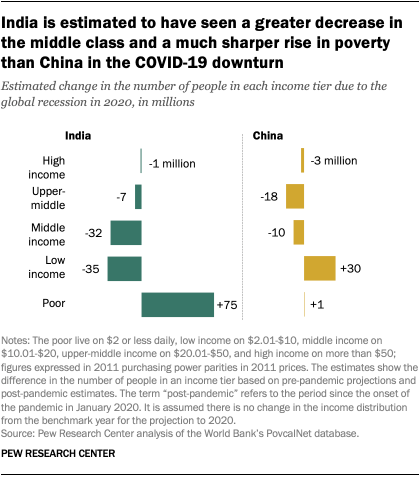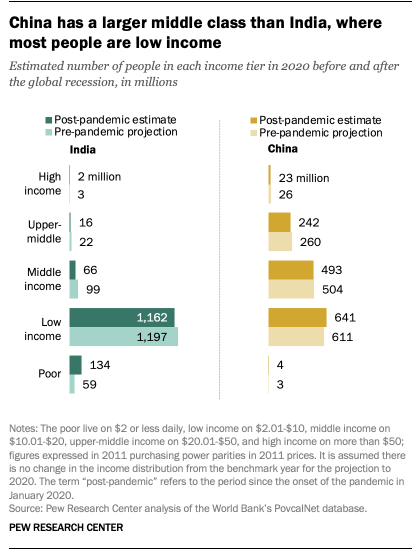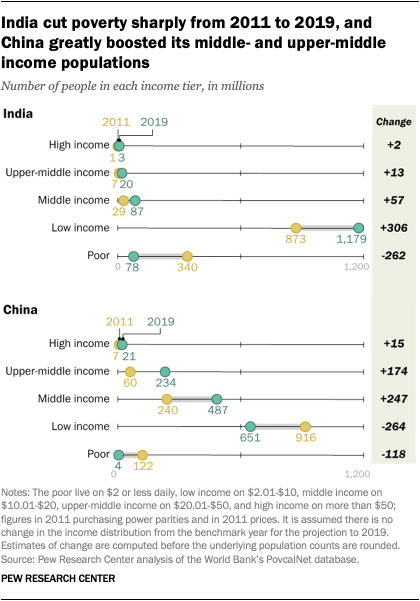
The economic crisis driven by the novel coronavirus is having a major impact on global living standards, pushing millions of people out of the middle class or into poverty. India and China, the world’s third largest and largest economies, respectively, exert significant influence on these trends. But the pandemic’s economic impact on India and China has been very different.
Given that India and China also account for more than a third of the global population, with about 1.4 billion people each, the course of the pandemic in these two countries – and how each recovers – will have a substantial effect on changes in the distribution of income at the global level.
The COVID-19 pandemic has created an economic crisis, shuttering businesses and cutting jobs around the world. This analysis looks at how the downturn has affected the standard of living in India and China, the two most populous countries in the world.
The focus is on the distribution of people across five income tiers in 2020: poor, low income, middle income, upper-middle income and high income. See the methodology and an earlier Pew Research Center report for more on the definition and meaning of these tiers in a global context.
The key data source for the analysis is the World Bank’s PovcalNet database, which provides access to household survey data on either income or consumption for more than 160 countries. The latest year for which survey data on the numbers of people in each income tier are available is 2011 for India and 2016 for China. These benchmark estimates are extrapolated to 2020 using World Bank estimates of output growth through 2020. One projection is based on the World Bank’s January 2020 forecasts of economic growth in 2020, and the other is based on its January 2021 estimates of growth in 2020. The difference between these two measures is used to represent the effect of the pandemic on the income distribution in each country.
While India plunged into a deep recession in 2020, China was able to forestall a contraction. In January 2020, economic forecasts from the World Bank pointed to virtually the same growth in real gross domestic product (GDP) in India (5.8%) and China (5.9%) in 2020. In January 2021, nearly one year into the pandemic, the World Bank revised these growth estimates downward to -9.6% for India but forecast 2% growth for China.
A new Pew Research Center analysis finds that the middle class in India is estimated to have shrunk by 32 million in 2020 as a consequence of the downturn, compared with the number it may have reached absent the pandemic. This accounts for 60% of the global retreat in the number of people in the middle-income tier (defined here as people with incomes of $10.01-$20 a day).
Meanwhile, the number of people who are poor in India (with incomes of $2 or less a day) is estimated to have increased by 75 million because of the COVID-19 recession. This, too, accounts for nearly 60% of the global increase in poverty. Perhaps not surprisingly, media reports from India point to a spike in participation in its rural employment program – originally intended to combat poverty in agricultural areas – as the many who have lost jobs in the reeling economy seek work. The number now participating is setting record highs in the program’s 14-year history.
The change in living standards in China is more modest than in India. The largest impact in China is the estimated addition of 30 million people to the low-income tier (incomes of $2.01-$10 a day). The number of people in the middle-income tier likely decreased by 10 million, and poverty was virtually unchanged.
Defining the income tiers
The population in each country is divided into five groups: poor, low income, middle income, upper-middle income and high income. The poor live on $2 or less daily, low income on $2.01-$10, middle income on $10.01-$20, upper-middle income on $20.01-$50 and high income on more than $50. All dollar figures are expressed in 2011 prices and purchasing power parity dollars, currency exchange rates adjusted for differences in the prices of goods and services across countries.
The assignment to a group, or income tier, is based on a household’s daily per capita income or consumption, a simple way of controlling for differences in household size. The terms “income” and “consumption” are used interchangeably for the sake of convenience, as are the terms “middle income” and “middle class.” An earlier Pew Research Center report discusses these concepts and the choice of income thresholds in greater detail.
The contrast in how living standards have evolved in India and China amid the pandemic is starker in the context of where they stood prior to the pandemic.
Prior to the pandemic, it was anticipated that 99 million people in India would belong in the global middle class in 2020. A year into the pandemic, this number is estimated to be have been 66 million, cut by a third. Meanwhile, the number of poor in India is projected to have reached 134 million, more than double the 59 million expected prior to the recession. The poverty rate in India likely rose to 9.7% in 2020, up sharply from the January 2020 forecast of 4.3%.
Most people in India were in the global low-income tier in 2020. Some 1.20 billion people in India were expected to be in this tier in 2020 prior to the pandemic, accounting for 30% of the world’s low-income population. This number is projected to have dropped to 1.16 billion as the COVID-19 downturn pushed more people into poverty.
In China, there are more people in the global middle- and upper-middle income tiers than in poverty and the low-income tier. Although about 10 million people in China are estimated to have fallen out of the middle class in the downturn, this is a small share of the 504 million who were in the middle class ahead of the pandemic. Likewise, the expansion of the low-income tier in China from 611 million to 641 million or the number of poor from 3 million to 4 million during the pandemic is comparatively modest in number.
Importantly, China accounted for 37% of the global middle-income population heading into 2020. Because economic growth in China remained positive, even if slower than anticipated, the limited impact on its middle class helped to ease the strain on the global middle class.
For both India and China, the drop in living standards in 2020 is a sharp departure from recent trends. From 2011 to 2019, the number of poor in India is estimated to have decreased from 340 million to 78 million. The projected rise in poverty in 2020 when comparing pre-pandemic and revised figures – 75 million – claws back several years of progress on this front for India. The retreat of India’s middle class in 2020 – by 32 million – also looms large in the context of the addition of 57 million to this income tier from 2011 to 2019.
In China, there had been a sizable addition of 247 million people to the middle-income tier from 2011 to 2019. Meanwhile, the upper-middle income population had nearly quadrupled, from 60 million to 234 million. On both fronts, China alone had accounted for the majority of the increase in these tiers globally. Thus, the pandemic-driven pause on these fronts in China is also a letup for the world at large.
Note: Here is the methodology for this report.



